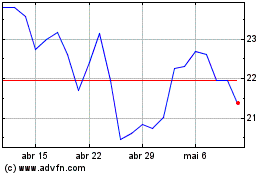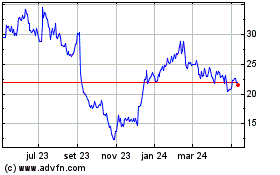New Research Illustrates How to Drive Earlier Diagnosis and Treatment of Kidney Disease
10 Junho 2024 - 11:26AM
Business Wire
A new survey in partnership with the National
Kidney Foundation finds that discussions between patients and
providers, and patient activation, are key to helping high-risk
patients take preventive actions to manage their kidney health
New research published in The American Journal of Accountable
Care by Phreesia, in partnership with The National Kidney
Foundation (NKF), found that even eight years after patients are
diagnosed with diabetes and/or hypertension, many do not know that
these conditions put them at high risk for chronic kidney disease
(CKD). The study finds that discussions between a patient and their
providers and patient activation play a significant role in
detecting and preventing CKD, one of the leading causes of death in
the United States.
In a month-long survey of 4,445 patients with diabetes and/or
hypertension, two of the most prevalent risk factors for CKD,
results showed a significant gap in awareness—two in three of these
high-risk patients were not aware of their risk for kidney disease.
The study uses the Patient Activation Measure® (PAM®) to evaluate
surveyed patients' knowledge, skills and confidence in managing
their own health. Highly activated patients feel comfortable
advocating for themselves and asking for support from their care
team to manage their own health, while low-activation patients need
more targeted support and resources. The study found that, of those
surveyed:
- 70% of highly activated patients with diabetes have discussed
kidney health with their healthcare provider, compared to just 38%
of low-activation patients with diabetes.
- 51% of highly activated patients with hypertension have
discussed kidney health with their healthcare provider, compared to
just 7% of low-activation patients with hypertension.
Critically, the study goes one step further, identifying that
patient activation and the frequency of patient-provider
conversations are the "two most powerful" factors in predicting
whether patients pursue preventive behaviors to safeguard their
kidney health. For example, patients who were highly activated and
had frequent conversations with their providers were more likely to
engage in daily lifestyle changes, like measuring their salt
intake. The study is particularly relevant to the care of older
adults, given the mean age of the study population was 58.8
years.
“Given what we know about treatments that can prevent the
progression of kidney disease, patients with diabetes and
hypertension remain unaware, untested and untreated for CKD for way
too long,” said Hilary Hatch, Chief Clinical Officer at Phreesia.
“These results have huge implications for how to increase
awareness, which in turn would speed up diagnosis and treatment.
Phreesia is well-positioned to do this because we can deliver
personalized messages to patients at the point of care, prompting
conversations with providers and supporting patients to take a more
active role in adopting behaviors to manage their kidney
health.”
The survey results also reinforce the notion that patients who
can independently manage their health generally have better
outcomes, finding that patients with higher activation levels are
significantly more likely to have discussed kidney health with
their provider. Additionally, activated patients with diabetes or
hypertension are more aware of the link between their current
condition and kidney health.
“This research illustrates that the frequency of
patient-provider conversations and patient activation influence
patient awareness of their risk for CKD,” said Elizabeth
Montgomery, National Vice President of Learning Strategies and
Population Health Programs at the National Kidney Foundation and
co-author of the research. “Strategies to improve patient
initiation of conversations with their clinicians regarding kidney
disease risk is one pathway to improve the low rates of CKD testing
and diagnosis in the U.S.”
CKD affects an estimated 37 million people in the U.S. Because
early stages have no symptoms, it is a silent killer—approximately
90% of those with CKD don't know they have it. This study found
that even eight or more years after receiving one of these two
high-risk diagnoses, 43% of surveyed patients with diabetes and 78%
of surveyed patients with hypertension were still unable to
identify their risk for kidney disease.
To bridge this awareness gap, it is critical to encourage
patient-provider conversations about kidney health and support
activation in patients. There is also growing recognition that
educating and engaging patients in their care helps drive
preventive behaviors. Using the PAM as a predictor of a patient’s
awareness of kidney disease risk and engagement, providers can
tailor interventions to each patient based on their activation
level. Assessments of patient activation are already in use as a
quality measure in some kidney care programs, like the Center for
Medicare and Medicaid Innovation Kidney Care Choices (KCC)
Model.
For more information on Phreesia, visit www.phreesia.com.
About Phreesia
Phreesia is the trusted leader in patient activation, giving
providers, life sciences companies, payers and other organizations
tools to help patients take a more active role in their care.
Founded in 2005, Phreesia enabled approximately 150 million patient
visits in 2023—more than 1 in 10 visits across the U.S.—scale that
we believe allows us to make meaningful impact. Offering
patient-driven digital solutions for intake, outreach, education
and more, Phreesia enhances the patient experience, drives
efficiency and improves healthcare outcomes. To learn more, visit
phreesia.com.
View source
version on businesswire.com: https://www.businesswire.com/news/home/20240610884791/en/
Media Contact: Nicole Gist nicole.gist@phreesia.com
407-760-6274
Phreesia (NYSE:PHR)
Gráfico Histórico do Ativo
De Dez 2024 até Jan 2025

Phreesia (NYSE:PHR)
Gráfico Histórico do Ativo
De Jan 2024 até Jan 2025
